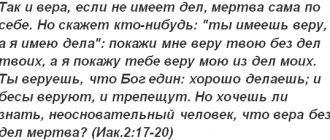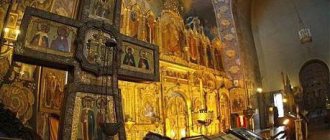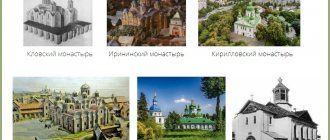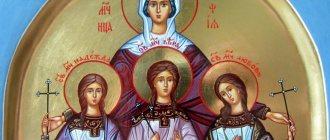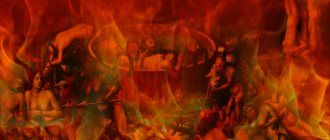Russia is a huge state that unites many nations with one word “Russians”. However, this does not prevent each nation from having its own religious traditions and customs. Many foreigners are surprised and delighted by how our country treats the issue of religion. In Russia, no religious movement can assume dominant status, since at the legislative level the country is recognized as a secular state. Therefore, peoples can choose for themselves the faith they want, and no one will persecute them for it. But still, what religions exist in Russia? Are there really so many different movements in the country that peacefully coexist with each other? We will try to answer these and other questions in the article.
Let's consider the topic through the prism of the law
Freedom of religion in Russia is constitutionally enshrined. Citizens decide for themselves what exactly to believe in and which churches to visit. You can also always remain an atheist and not support any of the faiths. And there are a lot of them on the territory of the country: according to the latest data, seventy religious denominations have been identified that are actively operating in the state. Based on this, we can safely conclude that the issue of religion in Russia is not a pressing issue. Believers respect each other's rights and freedoms without encroaching on alien religious traditions.
At the legislative level, there is a ban on insulting the feelings of believers and committing actions that can be interpreted as disrespect for them. Criminal penalties are provided for such acts.
This attitude towards religion ensures the inviolability and immutability of freedom of religion in Russia. Many scientists believe that this is historically predetermined. After all, our country has always been a multinational state where conflicts based on religious hatred have never arisen. All nations and peoples have respected each other's rights and beliefs for many centuries. This situation continues to this day.
However, many are interested in what religion in Russia can be considered the most important? Let's look for the answer to this question together in the following sections of the article.
Functions of religion
Main functions of religion:
- Worldview. Religion forms a certain picture of the world among its followers. Through the prism of faith, a person sees and understands the world, society and himself.
- Value-semantic. Religion answers questions about the meaning and purpose of life, and participates in the creation of value guidelines.
- Psychological (compensatory). Through prayer, meditation or turning to God, a believer receives consolation in difficult times and relieves stress.
- Communicative. A common faith unites people and makes it possible to feel included and not alone. In addition, through religious rituals, a believer can turn to saints, God, angels, etc.
- Cultural-transmitting. Religion can be a factor in the development of art; cultural heritage is transmitted through religious works.
- Educational. Religion contributes to the socialization of a person and instills certain rules of behavior in society.
- Regulatory. Faith organizes human aspirations and activities.
- Integrating and disintegrating. Religion unites groups of believers, but at the same time pits social groups professing different religions against each other.
Examples of the functions of religion: self-examination
Consider what functions of religion are evident in these examples. You will find the correct answers at the end of the article.
- In 1815, Russia, Prussia and Austria entered into the so-called Holy Alliance, the purpose of which was to suppress revolutionary sentiments. Later, other Christian monarchies also joined the union.
- The synagogue runs language courses where anyone can learn Hebrew for free and get to know Jewish traditions and culture better.
- The establishment does not sell alcohol, since the owner and most of the visitors are Muslims, and the Koran prohibits the consumption of alcohol.
We will help you consolidate new material in social studies courses at the Skysmart online school.
Religious composition of the population of Russia
Types of religion in Russia are not difficult to determine. This can be done approximately by every resident of the country who has a sufficient number of friends and acquaintances. Most likely, among them there will be Christians, Buddhists and even adherents of Islam. However, these are not all religions represented in the state. In fact, each of them has branches and a few religious associations. Therefore, in reality, the religious “carpet” looks much more colorful.
If we rely on official statistics, then the main religion in Russia can be called Christianity. It is noteworthy that most of the population adheres to it. But at the same time, religion is represented by all the main branches:
- Orthodoxy;
- Catholicism;
- Protestantism.
What religion in Russia can be placed in second place in terms of prevalence? Oddly enough for many, this religion is Islam. It is confessed mainly in the south of our country.
The third and subsequent places are occupied by Buddhism, Taoism, Judaism and other religious movements. In the next section we will talk in more detail about the religion of the peoples of Russia.
What is this in a person’s life
In any religion, faith itself, as a rule, is considered one of the fundamental virtues. In the teachings about Christ, the concept in question is belief in the completely unknown, in the invisible, but desired.
Belief in God in philosophy consists of a firm belief in the absence of evidence. When there are irrefutable facts, evidence, evidence, there is no talk of faith. A person does not believe that the planet is round, he just knows it. Discussions about faith begin only as a result of the desire to replace facts with feelings.
Philosophy explains belief in the Creator by the difficult conditions of the existence of society, namely the weakness of people to resist natural disasters, powerlessness in the face of other environmental conditions, as well as the need to compensate for such powerlessness, to replenish their detached existence with a ghostly other world that meets their needs. It was fear that first gave birth to the demiurges.
Theology recognizes faith as an inseparable feature of the human soul or as a grace bestowed by the Creator. This is where faith differs from knowledge.
Philosophy presupposes free-thinking and is not reduced to dogma. The thinker realizes that his view is only one of many views. Even if a philosopher is convinced of the truth of his own belief, he still respects other positions, points of view, and judgments. Because he understands that any philosophical statement is a paradox and a multiply interpreted phenomenon.
Belief in God in philosophy is the result of the rejection of knowledge. At the same time, it covers a part of knowledge, containing ideas, the justification of which or, on the contrary, refutation is currently impossible.
Belief in the Almighty is not simply a fact of accepting ideas about his reality. This feeling is the main component of the path of spiritual maturation. Faith in God simultaneously contains a certain attitude of a person towards his own person (soul, internal component), towards other living beings and the Creator. Belief is an energy information channel connecting subjects with the Creator.
Faith, hope and aspiration are the most significant forms of faith. Personal righteousness is a consequence of personal choice. And faith as a principle of power rests on the constant practice of a submissive behavioral pattern.
Many individuals who claim to truly believe in God actually lack true faith. Accepting the idea itself without engaging the senses is not true faith.
Genuine faith in the Creator gives people:
– a powerful surge of energy;
– access to hidden (internal) energy resources (access to the reserves of one’s own soul, namely knowledge, intuition, abilities);
– the ability to think adaptively;
– motivation and desire to act;
– activity;
- confidence;
– strength to overcome external obstacles and internal obstacles;
- feeling of happiness.
Statistical data
To find out about religion in Russia in percentage, you need to turn to official sources. However, there is some tension with them in the country. The fact is that thanks to freedom of religion, the state does not control the number of believers. It cannot provide accurate data on the confessions and religious self-identification of citizens. Therefore, it is possible to extract any useful information only from sociological surveys of the population, and it is difficult to vouch for their reliability. Moreover, most of the data from sociologists is quite contradictory and only after a thorough comparative analysis can any conclusions be drawn.
If we focus on the latest data from the Russian Academy of Sciences (2012-2013), then in percentage terms the religious picture looks like this:
- Seventy-nine percent of respondents consider themselves Orthodox;
- Muslims – four percent of Russians;
- no more than one percent of the country’s citizens identified themselves with other religious movements;
- Nine percent of respondents did not identify themselves with any religion;
- Seven percent of the population called themselves atheists.
And here is what the list of religions in Russia for the same years looks like in percentage according to data from one of the sociological organizations:
- Sixty-four percent of Russians profess Orthodoxy;
- other Christian movements - one percent;
- Islam – six percent;
- other religions – one percent;
- About four percent of citizens cannot self-determinate.
As you can see, information from different sources is slightly different from each other. However, such statistics of religions in Russia do not distort the overall picture.
Christianity in Russia
Over the past decades, the population of our country has increasingly begun to return to the religious traditions of their ancestors. People again flocked to churches and began to try to observe religious traditions and regulations. Most of the population remained faithful to the traditional religion - Christianity. In Russia it is professed by more than half of the country's population. However, not all of those who identify themselves with this religion attend temples and services. Most often they are called Christians nominally, meaning by this the centuries-old traditions of the Slavic people as a whole.
But we should not forget that the religion itself has several movements and representatives of almost each live on the territory of the Russian state:
- Orthodoxy;
- Catholicism;
- Protestantism;
- Old Believers and other movements that are not numerous in composition.
If we state the facts without going into details, then the overwhelming majority of followers of religion in Russia is Orthodoxy. And only then do the rest of the currents follow. But they all definitely deserve respect and attention.
List and brief history of the world's major religions
There are three famous world religions. These are Christianity, Islam and Buddhism.
Christianity first appeared in the Roman Empire in the first century. From there came all the writings about the life of Jesus, who at a young age was crucified on the cross so that all the sins of people would be forgiven.
After this, he was resurrected and incarnated as the son of God, a supernatural force.
The Holy Scripture, which preserves the teachings of Christianity, is called the Bible. Consists of two collections: the Old Testament and the New Testament. People who believe in Christianity go to church, pray, fast, celebrate holidays, and perform various sacraments.
Types of Christianity: Orthodoxy, Catholicism and Protestantism.
Orthodoxy strictly follows the faith and recognizes all 7 sacraments: baptism, communion, confirmation, priesthood, repentance, wedding and unction. Catholicism is somewhat similar.
Protestantism does not recognize the Pope as its head, considers faith to be independent, and is against church policy.
Islam is the religion of Muslims. It appeared among Arab tribes at the beginning of the 7th century. It was founded by the prophet Muhammad. He was a hermit, a loner, and often thought and philosophized about morality and piety.
According to legend, on his fortieth birthday, the Archangel Gabriel appeared to him and left an inscription on his heart. God in Islam is called Allah. The religion is very different from Christianity.
Buddhism originated in the 6th century BC. This is the most ancient religion. The origins come from India, then it began to spread to China and the Far East.
The main founder is Buddha Gautama. At first he was an ordinary person. His parents once had a dream that their child would be a great man, a mentor. He was always very lonely, prone to thoughts, only religion and philosophy were important to him.
In Buddhism there is no specific God that everyone worships. Buddha is just an ideal of what one should become. Bright, pure, kind, highly moral. The goal of religion is to achieve a blissful state, achieve insight, free yourself from shackles, find yourself, find peace and tranquility.
In addition to the main three religions, there are others. This is very ancient Judaism.
It is based on the Ten Commandments that God prophesied to Moses.
This is also Taoism, which has teachings that all things appear from nowhere and go to nowhere, the main thing is harmony with nature.
It was founded by a philosopher who lived in the 4th century.
Other known religions are Confucianism, Jainism, and Sikhism.
Orthodoxy
If we are talking about which religion in Russia - Orthodoxy or Christianity - can claim the title of “main religion”, then it is worth noting the incompetence of the question itself. For some reason, many who are ignorant of religious issues separate these concepts and place them on opposite sides of the barrier. However, in fact, Orthodoxy is just one of the equal denominations of Christianity. But in our country its followers are the majority of the population.
According to some estimates, more than eighty million people profess Orthodoxy. They live in different regions of the Russian Federation and predominate in them. Naturally, the bulk of believers are Russian. But there are many Orthodox peoples among other peoples, and they include themselves:
- Karelians;
- Mari;
- Chukchi;
- Enets;
- Evenks;
- tofalars;
- Kalmyks;
- Greeks and so on.
Sociologists count at least sixty nationalities that, out of a large number of types of religions in Russia, make their choice in favor of Orthodoxy.
Catholicism
This religion has been present in Russia since the adoption of Christianity. Over the centuries, the size of the community has constantly changed, as has the attitude towards the confession. At some times, Catholics enjoyed great respect, at others they were persecuted by government authorities and the Orthodox Church.
After the revolution of the seventeenth year, the number of Catholics decreased significantly and only in the nineties, when attitudes towards religion in general changed, followers of the Latin rites began to actively open their churches in Russia.
On average, there are about five hundred thousand Catholics in our country; they have formed two hundred and thirty parishes, united in four large dioceses.
Protestantism
This Christian denomination is one of the largest in our country. According to data from three years ago, it has about three million people. Such an incredible number of believers may raise doubts about the accuracy of the calculations, but it must be taken into account that the Protestant community is divided into numerous movements. These include Baptists, Lutherans, Adventists and other communities.
According to sociological services, among Christian denominations, Protestants are second only to Orthodox Christians in terms of the number of believers.
Orthodox associations in Russia: Old Believers
We have already mentioned that numerous religions in Russia, including Christianity, are fragmented into small groups that differ from each other in rituals and forms of service. Orthodoxy is no exception. Believers do not represent a single structure; they belong to different movements that have their own parishes and churches.
The vast Russian expanses are home to a vast community of Old Believers. This Orthodox movement was formed in the seventeenth century after the rejection of church reform. Patriarch Nikon ordered that all religious books be brought into conformity with Greek sources. This caused a split in the Orthodox Church, which continues to this day.
At the same time, the Old Believers themselves are not united either. They are divided into several church associations:
- priests;
- Bespopovtsy;
- fellow believers;
- Old Orthodox Church;
- Andreevtsy and similar groups.
According to fairly rough estimates, each association has several thousand followers.
Islam
Data on the number of Muslims in Russia are often distorted. Experts say Islam is practiced by about eight million people in the country. But the highest clergy themselves give completely different figures - approximately twenty million people.
In any case, this figure is not static. Sociologists note that every year there are two percent fewer adherents of Islam. This trend is associated with military conflicts in the Middle East.
It is noteworthy that the majority of Muslims call themselves “ethnic”. They are traditionally associated with this religion, but they themselves do not adhere to certain rituals and traditions and very rarely visit the mosque.
Historians note that the Slavs are very closely associated with Islam. In the fourteenth century, it was the state religion in part of Russian territories. Once they were Muslim khanates, but were annexed to the lands of Rus' as a result of conquest.
The most numerous people professing Islam are the Tatars. They play an important role in governing the faith and preserving the cultural traditions of their ancestors.
Armenia
Now let's study the religion of the Armenians. What is it? It is known that most of the inhabitants of Armenia are Christians who call themselves adherents of the Armenian Apostolic Church. Christianity appeared in this country in the 1st century AD. e. It was then that Christ’s apostles Bartholomew and Thaddeus, who are considered supporters of the Apostolic Armenian Church, preached here.
It is known that at the beginning of the 4th century (the traditional date is 301), King Trdat III declared Christianity the state religion. This is how Armenia turned into the first Christian state on Earth.
Faith and Orthodoxy are an integral part of the life of almost every Armenian. Thus, the 2011 census of residents of Armenia states that Christianity of various denominations in the state is professed by 2,858,741 souls. This figure indicates that this country has 98.67% God-fearing population.
The religion of Armenians is not the same: 29,280 believers worship the Armenian Evangelical Church, 13,843 - the Armenian Catholic Church, 8,695 consider themselves Jehovah's Witnesses, 7,532 call themselves Orthodox (Chalkadonites), 2,872 - Molokans.
By the way, the Apostolic Armenian Church is among the Orthodox Oriental churches. These include: Coptic, Eritrean, Ethiopian, Malankara and Syrian.
Judaism
There are at least one and a half million representatives of this religious movement in Russia. The majority of them are Jewish people. Jews live mainly in large cities. Approximately half of the believers settled in Moscow and St. Petersburg.
Today there are seventy synagogues operating in the country. A distinctive feature of Jews living in Russia is their adherence to traditions. They regularly attend the synagogue with the whole family and perform all the required rituals.
Buddhism
There are about two million Buddhists in our country. This is mainly the population of three Russian regions:
- Buryatia;
- Tuva;
- Kalmykia.
The majority of representatives of this faith are ethnic Buddhists. From generation to generation they profess the same religion and pass on traditions to their children. Over the past decades, Buddhism has become extremely popular. Many people begin to study its basics out of interest and then become its active followers.
The popularization of this religious movement is evidenced by plans to build a datsan in Moscow. This temple should turn out to be one of the largest and most luxurious in Russia.
Clericalization
We all know that the Creator of the Universe is great! Religion penetrates into all spheres of public life. It can also be found in those areas that, according to the Constitution, are separated from faith: in schools, the army, government agencies, science and education. It is known that the State Duma agreed with the Moscow Patriarchate to conduct preliminary consultations on all points that raise doubts. In schools in the Russian Federation, students began to study the basics of religious cultures; in some universities in the country there is a specialty in theology.
A new position was introduced into the staffing table of the Armed Forces - chaplain (military priest). A huge number of departments, ministries, and government agencies own their own churches. Very often these ministries have public councils that cover religious topics.
Other religions and common beliefs
The low percentage of followers of some beliefs does not allow them to be identified as large and significant denominations, however, in recent years there has been an intensification of all kinds of religious associations.
Of great interest is the occult, eastern practices and neo-pagan cults. These movements have their own rituals, traditions and norms of service. Every year, the Orthodox Church notes with great concern the growth of followers of various religious beliefs. However, they have not yet been able to contain it.
Don't forget about shamanism. Many peoples, including the Udmurts, Mari and Chuvash, despite the fact that they self-identify as Orthodox, remain committed to the ancient rites and rituals of their ancestors. Shamanism is very developed in these territories.
Residents of remote Russian villages are also returning to the faith of their ancestors. In settlements you can often meet followers of the Rodnovers. They revive long-forgotten traditions and worship the forces of nature. There is also such a movement as folk Orthodoxy. It is somewhat akin to paganism, but has bright distinctive features.
Neopaganism
Aren't you tired of studying the endless religions of peoples? So, we continue to further analyze this interesting topic. The 2011 census shows that there are 5,434 pagan supporters living in Armenia.
The neo-pagan religious movement is called Getanism. It recreates the established Armenian pre-Christian dogma. Getanism was founded by armenologist Slak Kakosyan on the basis of the writings of Garegin Nzhdeh, the most famous Armenian nationalist.
All neo-pagan sacraments are constantly carried out in the Garni temple. The head of the Armenian pagan communities is the priest Petrosyan Zohrab. No one knows the specific number of followers of this faith. In general, Armenian neo-paganism is popular, as a rule, among fans of ultra-right and nationalist movements.
It is known that well-known Armenian politicians considered themselves titanists: Ashot Navasardyan (founded the ruling Republican Armenian Party) and Margaryan Andranik (former prime minister of the country).
Prohibited religions in Russia
Despite the fact that freedom of religion is sacredly observed in our country, there are certain organizations that are prohibited in Russia. Destructive sects and extremist groups fall into this category. What should be understood by this formulation? Let's try to figure it out.
A person does not always come to faith in a simple and understandable way. Sometimes on his road he meets people who are members of religious groups. They obey the spiritual leader and are often completely under his control. The organizers of such groups have hypnotic abilities, knowledge of neurolinguistic programming and other talents that allow them to control the masses. Associations with leaders who skillfully manage and direct their flock in a way that harms their mental and physical health, as well as material well-being, are called “sects”. Moreover, most of them have the prefix “destructive”. They influence people's consciousness and make money at their expense. Unfortunately, many such organizations appeared in Russia. We will mention some prohibited sects in this section in more detail:
- "White Brotherhood" The leader of the organization was a former KGB officer who skillfully applied his knowledge in practice. About ten years ago, the leadership of the sect found itself in the dock, but before that they managed to literally zombify several thousand people. They completely lost their property and went to live in a sect, where they eked out a powerless existence from hand to mouth.
- "Neo-Pentecostals". The sect that came to us from America managed to recruit about three hundred thousand adherents of different ages into its ranks. The goal of the organization's leaders was enrichment. They skillfully controlled the crowd, bringing them to almost ecstasy with their words and colorful show. In this state, people were ready to give all their property to the leaders and be left with nothing.
- "Jehovah witnesses". This sect is familiar to almost every Russian; its adherents have a habit of knocking on every apartment in search of new members of the organization. The technology for recruiting sectarians is so finely thought out that people did not even notice how they became part of a religious organization. However, the leaders’ activities pursued purely mercantile goals.
Many extremist organizations that base their activities on religious beliefs and exist for the sake of terror are unknown to the average person. However, their list is quite extensive; we cannot list it in full within the scope of this article. But let's list some groups:
- "Islamic State". There is hardly a person who does not know this name. An organization that carries out terrorist attacks around the world has been banned in Russia for two years.
- Jabhat al-Nusra. The group is also considered a banned religious terrorist group.
- "Nurcular". This organization is international and its activities on the territory of our country are punishable by the laws of the Russian Federation.
Many countries believe that the example of Russia, which managed to unite many peoples and religious movements, must be considered on a global scale. Indeed, in some states the problem of religion is very acute. But in our country, every citizen chooses for himself which god he should believe in.
The most widespread religions in the world for 2022
The most widespread religion in the world at the beginning of 2022 is Christianity; it is professed by over 2.4 billion people around the world. However, over the past many years, the leader in the increase in the number of followers among religions has been Islam. Despite its relative youth (Islam appeared 600 years after Christianity), this religion is spreading at the fastest pace. This is largely due to the demographic difference between confessors. The number of children in Muslim countries significantly exceeds the number of newborns in peasant families over the past 100 years. Currently, the number of Muslims around the world has reached 1.9 billion people.
The number of atheists and agnostics (non-believers) on Earth is also significant - there are about 1.2 billion of them. The leaders of the world's religions in terms of prevalence also include Hinduism - about 1.15 billion and Buddhism - over 520 million people.
A more detailed list of the most common religions in the world for 2021 is outlined in the table below.
| Religion | Believers | Share |
| Christianity | 2.4 billion | 29,81% |
| Islam | 1.9 billion | 24,60% |
| Atheists/Agnostics | 1.2 billion | 13,91% |
| Hinduism | 1.15 billion | 14,28% |
| Buddhism | 521 million | 6,47% |
| Chinese folk religion | 394 million | 4,89% |
| Ethnic religions | 300 million | 3,37% |
| African traditional religions | 100 million | 1,24% |
| Sikhism | 30 million | 0,37% |
| Spiritualism | 15 million | 0,19% |
| Judaism | 14.5 million | 0,18% |
| Baha'i | 7.0 million | 0,09% |
| Jainism | 4.2 million | 0,05% |
| Shintoism | 4.0 million | 0,05% |
| Cao Dai | 4.0 million | 0,05% |
| Zoroastrianism | 2.6 million | 0,03% |
| Tenrikyo | 2.0 million | 0,02% |
| Neopaganism | 1.0 million | 0,01% |
| Unitarian Universalism | 0.8 million | 0,01% |
| Rastafarianism | 0.6 million | 0,01% |
In addition to those listed above, Taoism and Confucianism are also very widespread religions in the world, but there is no official data on the exact number of their followers. According to some estimates, their number ranges from 5 to 10 million believers.

